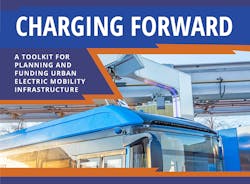USDOT releases toolkit to help larger communities take full advantage of federal funding for EV charging stations
The U.S. Department of Transportation (USDOT), in collaboration with the U.S. Department of Energy and the Joint Office of Energy and Transportation (Joint Office), released a free technical resource to help larger communities take full advantage of federal funding for electric vehicle (EV) charging stations and other forms of electric transportation. The toolkit, Charging Forward: A Toolkit for Planning and Funding Urban Electric Mobility Infrastructure, provides a comprehensive resource for communities, metropolitan planning organizations, transportation providers, businesses and property owners and developers by including information on how to scope, plan and identify ways to best leverage billions of dollars in funding from the Infrastructure Investment and Jobs Act (IIJA).
The toolkit builds on the efforts of the Joint Office to provide states and communities across America with information and assistance to accelerate an electrified transportation system that is convenient, affordable, reliable and equitable. The toolkit also includes guidance to help urban areas implement other forms of electric transportation, such as public transit, electric bikes and scooters and ride-share services.
"Under President Biden’s leadership, we’re creating a generation of good-paying jobs – many of which don’t require a four-year degree – building a nationwide network of EV chargers,” said USDOT Secretary Pete Buttigieg. “This toolkit will help all communities, big and small, bring EV charging to their residents, which will lower costs for drivers, create jobs and reduce pollution.”
“Sustainable transportation solutions are headed to every community in the nation – rural, urban, and everywhere in between – thanks to President Biden’s Investing in America agenda,” said USDOT Secretary of Energy Jennifer M. Granholm. “This one-stop resource outlines access to technology in urban areas and funding to drive the future of an electrified, convenient and reliable transportation system across America.”
USDOT notes building an affordable and accessible public charging network will help make electric forms of transportation more convenient for the 71 percent of Americans who live in communities with a population over 50,000. While many EV owners can charge their vehicles at home or work, people who live in higher density areas, especially those living in apartments and condos, may not have easy access to a garage or the space for a private charger, which means they are more reliant on public charging options.
In September 2022, USDOT approved plans from all 50 states and the District of Columbia and Puerto Rico to build a nationwide network of EV chargers, supported by $5 billion from the IIJA’s National Electric Vehicle Infrastructure Program. This spring, USDOT opened the application process for the first $700 million of the total $2.5 billion in funding to build EV charging infrastructure in communities and neighborhoods across the country through the Charging and Fueling Infrastructure Discretionary Grant Program. Together, the funding represents the largest investment in EV charging in U.S. history and a key step towards meeting the Biden-Harris Administration’s goal of building 500,000 public EV chargers and reducing national greenhouse gas emissions by 50 to 52 percent by 2030.
The toolkit builds on recent progress towards the expansion of EV infrastructure, including the recently published minimum standards for federally funded EV infrastructure and President Biden’s EV charging Build America, Buy America requirements. In January, the Biden-Harris Administration released the first-ever blueprint to decarbonize the nation’s transportation sector and cut all transportation-related greenhouse emissions by 2050 – an interagency effort between USDOT, the U.S. Department of Energy, U.S. Department of Housing and Urban Development and the U.S. Environmental Protection Agency.
In May, USDOT released an updated Rural EV Toolkit that incorporated feedback from rural communities and stakeholders on the toolkit’s first iteration. The updated toolkit includes more information on EV charging programs and information on related topics like public transit. The revised toolkit and other rural EV resources are available at USDOT’s website.
The urban toolkit is available here and is included in the DOT Navigator – a one stop shop for accessing the range of federal transportation technical assistance resources.
